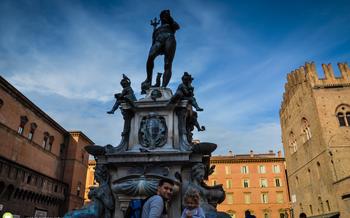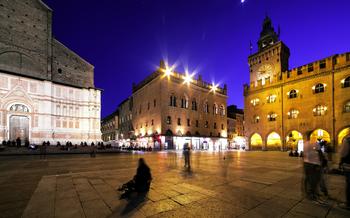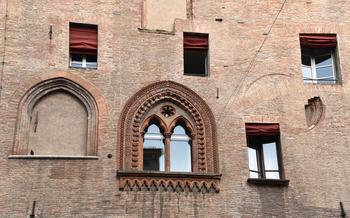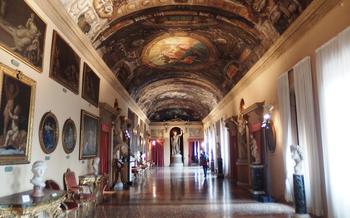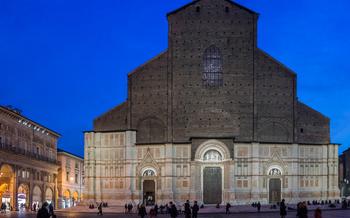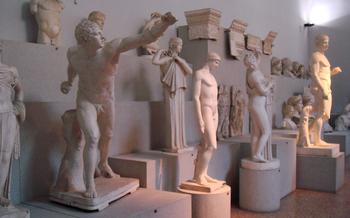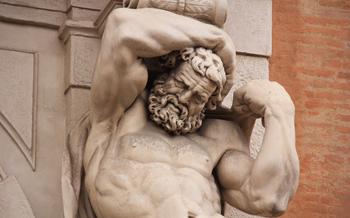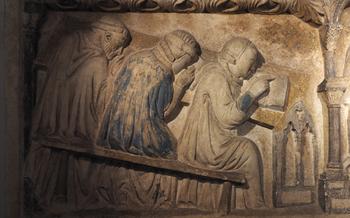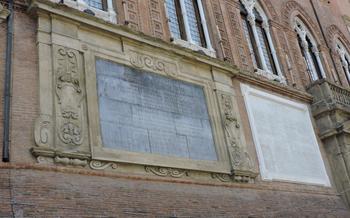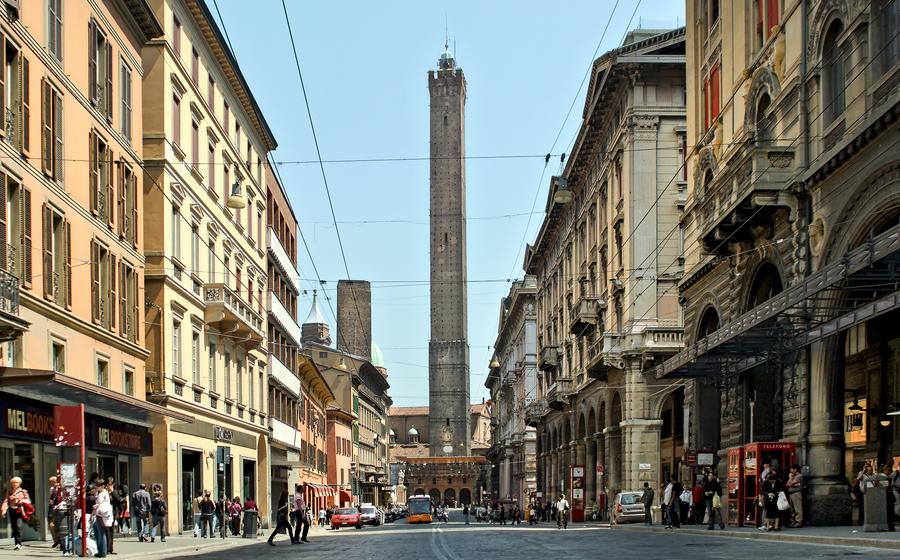
Torre degli Asinelli
- Introduction - The Historical Importance of Bologna and its Two Towers
- The Legend of the Two Towers - A Tale of Rivalry and Betrayal
- The Asinelli Tower - A Symbol of Strength and Resilience
- Climbing the Asinelli Tower - A Challenging but Rewarding Experience
- Piazza Maggiore - The Heart of Bologna
- Basilica di San Petronio - A Masterpiece of Gothic Architecture
- Fontana del Nettuno - A Symbol of Power and Abundance
- Palazzo d'Accursio - The Seat of the Municipal Government
- Archiginnasio di Bologna - The Oldest University in the Western World
- Shopping and Dining in the Area
- Photography Opportunities: Capturing the Essence of the Asinelli Tower
- Accessibility and Practical Information:
- Insider Tip - The Best Time to Visit:
Introduction - The Historical Importance of Bologna and its Two Towers
In the heart of the Emilia-Romagna region, lies the enchanting city of Bologna, a treasure trove of history, art, and gastronomy. Its roots can be traced to the Etruscan era, and it flourished during the Middle Ages as a vital trading and cultural center. The city's skyline is dominated by two iconic structures, the Asinelli Tower and the Garisenda Tower, which stand as symbols of Bologna's medieval power and architectural prowess. Built in the 12th century, these towers served as defensive structures, safeguarding the city from invaders. Their enduring presence has transformed them into beloved landmarks, drawing visitors from around the world to marvel at their grandeur and explore the rich history they embody.
The Legend of the Two Towers - A Tale of Rivalry and Betrayal
Legends are intertwined with the history of Bologna, and the construction of the Asinelli and Garisenda Towers is no exception. The Asinelli family, wealthy merchants, and the Garisenda family, powerful landowners, were fierce rivals. The legend tells of a passionate and forbidden love between Romeo, the son of the Asinelli family, and Juliet, the daughter of the Garisenda family.
Driven by their love, Romeo and Juliet decided to elope. Their families, fueled by hatred and rivalry, were furious. In an act of revenge, the Garisenda family hired a group of masons to build a tower taller than the Asinelli Tower. However, their plan backfired when the tower began to lean due to unstable foundations. The Garisenda Tower, forever unfinished, stands as a symbol of failed ambition and thwarted love.
The tragic love story of Romeo and Juliet, immortalized in Shakespeare's play, echoes in the leaning structure of the Garisenda Tower. It serves as a poignant reminder of the consequences of rivalry and the enduring power of love, even in the face of adversity. Like the tower itself, the legend of the two families has become an integral part of Bologna's rich history and folklore.
The Asinelli Tower - A Symbol of Strength and Resilience
Standing tall at 97 meters, the Asinelli Tower is a testament to the architectural prowess and resilience of Bologna. Constructed entirely of brick, the tower features a square base with a side length of 11 meters. Its imposing height is further accentuated by its 498 steep and narrow steps, which lead to a breathtaking panoramic view of the city. The tower's exterior is characterized by a series of decorative bands and cornices, which add visual interest and break the monotony of the brick façade. Despite its age, the Asinelli Tower has withstood the test of time, remaining structurally sound despite numerous earthquakes that have shaken the region. Its resilience is a symbol of the strength and fortitude of the city of Bologna, which has faced numerous challenges throughout its history but has always emerged stronger.
Climbing the Asinelli Tower - A Challenging but Rewarding Experience
Ascending the Asinelli Tower is a physical challenge that requires endurance and determination. The narrow and steep staircase, consisting of 498 steps, winds its way up the interior of the tower, providing a unique and intimate experience. The climb is not for the faint of heart, and visitors should be prepared for a strenuous workout. However, the effort is well worth it when reaching the summit.
Emerging at the top of the tower, visitors are greeted by a breathtaking 360-degree panoramic view of Bologna and its surroundings. The city unfurls before your eyes, showcasing its terracotta rooftops, medieval towers, and sprawling piazzas. The view extends far beyond the city limits, encompassing the rolling hills of the Apennines and the distant Adriatic Sea. It is a moment of pure exhilaration and awe, as visitors stand atop one of Bologna's most iconic landmarks, with the world seemingly at their feet.
The sense of accomplishment and pride in overcoming the challenge of the climb adds to the overall experience. Visitors can take their time at the summit, savoring the panoramic views, and capturing memories of this unique moment. Climbing the Asinelli Tower is not just a tourist activity but a personal journey that leaves a lasting impression on visitors, reminding them of their resilience and the beauty that lies in embracing challenges.
Piazza Maggiore - The Heart of Bologna
In the very heart of Bologna, where the vibrant energy of the city pulsates, stands Piazza Maggiore, a majestic square that has witnessed centuries of history and cultural transformation. This iconic square is home to some of Bologna's most treasured landmarks, including the Asinelli and Garisenda Towers, which rise majestically as symbols of the city's medieval power and prosperity.
Piazza Maggiore serves as the central gathering place for Bolognese people and visitors alike, a place where history, art, and community converge. The square is surrounded by an array of architectural wonders, each with its own unique story to tell. The towering Basilica di San Petronio, with its unfinished façade, stands as a testament to the city's enduring spirit and its commitment to preserving its rich heritage.
The lively atmosphere of Piazza Maggiore is further enhanced by the presence of numerous shops, boutiques, and restaurants that line its perimeter. Here, visitors can indulge in the local culinary delights, savor the flavors of traditional Bolognese cuisine, and immerse themselves in the city's vibrant culinary scene.
As night falls, the square transforms into a magical realm, illuminated by the warm glow of street lamps and the soft murmur of conversations. The Asinelli and Garisenda Towers, bathed in golden light, cast long shadows across the piazza, creating an enchanting atmosphere that invites visitors to linger and soak in the city's timeless charm.
Basilica di San Petronio - A Masterpiece of Gothic Architecture
In close proximity to the Asinelli Tower stands the magnificent Basilica di San Petronio, a testament to Bologna's rich architectural heritage. This awe-inspiring cathedral, dedicated to the city's patron saint, is a masterpiece of Gothic architecture, showcasing intricate details and soaring spires that pierce the sky.
Despite its grand scale, the basilica's façade remains unfinished, adding an air of mystery and intrigue to its appearance. Visitors are drawn to its asymmetrical design, featuring a single bell tower that stands tall, contrasting with the incomplete façade.
Inside, the basilica boasts an opulent interior adorned with stunning frescoes, intricate carvings, and opulent decorations. The vaulted ceilings, supported by graceful columns, create a sense of grandeur and awe. Among the many treasures housed within the basilica are the exquisite Cappella Maggiore, with its breathtaking altarpieces, and the Cappella dei Re Magi, adorned with a mesmerizing fresco depicting the Adoration of the Magi.
Basilica di San Petronio stands as a symbol of Bologna's devotion and artistic prowess. Its unfinished façade, far from being a flaw, serves as a reminder of the city's resilience and its ability to embrace both the past and the present.
Fontana del Nettuno - A Symbol of Power and Abundance
In the heart of Piazza Maggiore, just a stone's throw away from the Asinelli Tower, stands the majestic Fontana del Nettuno, a symbol of Bologna's power and abundance. Commissioned by Pope Pius IV in the 16th century, this monumental fountain is a masterpiece of Renaissance art, showcasing the talents of renowned sculptor Giambologna.
The fountain's centerpiece is a colossal bronze statue of Neptune, the Roman god of the sea, depicted in a dynamic pose as he struggles with sea creatures. The god's muscular physique and commanding presence symbolize the strength and authority of Bologna, a city that has long been a center of trade and commerce.
The fountain's elaborate basin is adorned with intricate carvings depicting mythological scenes, tritons, and sea nymphs. Water cascades down from the basin's upper tier, creating a refreshing spectacle that adds to the fountain's grandeur.
Beyond its artistic significance, the Fontana del Nettuno holds symbolic meaning for the city of Bologna. The fountain's abundance of water represents the city's prosperity and its role as a major trading hub. The statue of Neptune, with his trident pointed towards the Palazzo d'Accursio, the seat of the city government, symbolizes the power and authority of the city's rulers.
Palazzo d'Accursio - The Seat of the Municipal Government
In close proximity to the Asinelli Tower stands the Palazzo d'Accursio, an architectural masterpiece that serves as the seat of the municipal government of Bologna. Its history is intertwined with the city's political and administrative affairs, dating back to the 13th century when it was initially constructed. The palace underwent several renovations and expansions over the centuries, resulting in a harmonious blend of architectural styles.
The Palazzo d'Accursio is renowned for its grand façade, featuring a series of elegant arches and intricate carvings. Its courtyards, adorned with statues and fountains, offer a glimpse into the opulence and grandeur of the past. Inside the palace, visitors can explore the various halls and chambers, each with its own unique character and purpose. The Sala del Consiglio, or Council Chamber, is particularly impressive with its frescoed walls and ornate ceiling.
Beyond its administrative function, the Palazzo d'Accursio also houses the Museo Morandi, dedicated to the works of the renowned Bolognese artist Giorgio Morandi. The museum showcases a collection of paintings, drawings, and engravings, providing insights into Morandi's artistic journey and unique style.
Visiting the Palazzo d'Accursio is a must for anyone interested in the political history and cultural heritage of Bologna. The palace offers a fascinating glimpse into the workings of the city government and allows visitors to admire the architectural and artistic treasures it holds within its walls.
Archiginnasio di Bologna - The Oldest University in the Western World
Adjacent to the Asinelli Tower stands the Archiginnasio, a testament to the city's preeminent role in the realm of higher learning. Founded in 1088, it holds the distinction of being the oldest university in the Western world, continuing its legacy of imparting knowledge for over nine centuries.
The Archiginnasio is a treasure trove of architectural and historical significance. Its grand courtyard, adorned with coats of arms from various nations and cities, speaks to the university's global influence. The 16th-century Anatomical Theater, with its tiered wooden benches, evokes the pioneering spirit of medical education.
Visitors to the Archiginnasio can wander through its frescoed halls, marveling at the intricate artwork that adorns the walls and ceilings. Here, they can delve into the university's rich history through various exhibits, which showcase the instruments and artifacts used by renowned scholars of the past.
The Archiginnasio stands as a testament to Bologna's unwavering commitment to education and its indelible mark on the intellectual landscape of Europe. It is a must-visit for those seeking to explore the roots of modern academia and experience the vibrant energy of a university that has stood the test of time.
Shopping and Dining in the Area
The area surrounding the Asinelli Tower is a vibrant hub of shops, boutiques, and restaurants, catering to every taste and budget. From local artisans selling handmade souvenirs to international brands offering high-end fashion, there's something for every shopper.
Local Products and Specialties:
Indulge in the culinary delights of Bologna, renowned for its rich and flavorful cuisine. Try the traditional tortellini in brodo, a hearty pasta dish served in a flavorful broth, or the tagliatelle al ragù, a classic pasta with a slow-cooked meat sauce. Don't miss the mortadella, a cured pork sausage with a unique flavor, and the Parmigiano Reggiano cheese, a hard, granular cheese with a nutty taste.
Vibrant Atmosphere and Nightlife:
As the sun sets, the area around the Asinelli Tower comes alive with a lively atmosphere. Restaurants spill out onto the streets, inviting you to enjoy a leisurely dinner al fresco. Bars and pubs offer a wide selection of craft beers and local wines, while street performers entertain the crowds with their music and acrobatics.
Photography Opportunities: Capturing the Essence of the Asinelli Tower
The Asinelli Tower, with its distinctive silhouette and historical allure, presents a multitude of captivating photography opportunities. From its base, the tower's imposing height and architectural details can be captured in all their grandeur. Stepping back and capturing the tower amidst the bustling Piazza Maggiore, surrounded by historical buildings and landmarks, creates a dynamic composition that showcases the tower's integration into the urban fabric.
Photographers can also explore the picturesque streets and alleyways surrounding the tower, capturing unique perspectives that highlight its relationship with the surrounding cityscape. The interplay of light and shadow during different times of the day, especially golden hour, can transform the Asinelli Tower into a mesmerizing subject, casting long shadows that accentuate its verticality.
For a truly unforgettable shot, venture to the top of the tower and capture the breathtaking panoramic view of Bologna. The cityscape, with its terracotta rooftops, winding streets, and distant hills, provides a stunning backdrop for a photograph that encapsulates the essence of this historic city. Whether you're a professional photographer or simply seeking to capture a memorable souvenir, the Asinelli Tower offers endless possibilities for creative and captivating images.
Accessibility and Practical Information:
Visiting the Asinelli Tower is a must-do experience for any traveler to Bologna. The tower is open to the public from 9 am to 7 pm, with the last climb starting at 6 pm. To climb the tower, visitors need to purchase a ticket, which can be bought online or at the ticket office located at the foot of the tower. The ticket price is €5 for adults, €3 for children between 6 and 14 years old, and free for children under 6 years old.
For a more in-depth experience, guided tours are available in English and Italian. These tours typically last for about 45 minutes and provide visitors with a detailed history of the tower and its significance. Audio guides are also available for rent for those who prefer to explore the tower at their own pace.
The Asinelli Tower is fully accessible for visitors with disabilities or mobility issues. A dedicated elevator takes visitors to the top of the tower, ensuring that everyone can enjoy the breathtaking views of Bologna. Visitors with disabilities can purchase discounted tickets at the ticket office.
Before climbing the tower, it is essential to wear comfortable shoes, as the staircase is narrow and steep. It is also recommended to bring a camera to capture the stunning views from the top.
Insider Tip - The Best Time to Visit:
To fully appreciate the beauty of the Asinelli Tower and the surrounding area, it's crucial to choose the right time for your visit. The best period to visit Bologna is during the shoulder seasons, namely spring (April-May) and autumn (September-October). During these months, the weather is pleasant, with warm days and cool nights, making it ideal for outdoor activities and climbing the tower. Moreover, the crowds are smaller, allowing for a more tranquil and enjoyable experience.
For the most optimal experience, aim to visit the tower early in the morning or late in the afternoon. This strategy not only helps you avoid the midday heat but also ensures fewer visitors, granting you ample space to climb and take in the breathtaking views without feeling rushed. Additionally, consider visiting on a weekday rather than a weekend, as weekends tend to attract more tourists and locals alike.
By planning your visit strategically, you can maximize your enjoyment of the Asinelli Tower and capture the essence of Bologna's rich history and charm.
